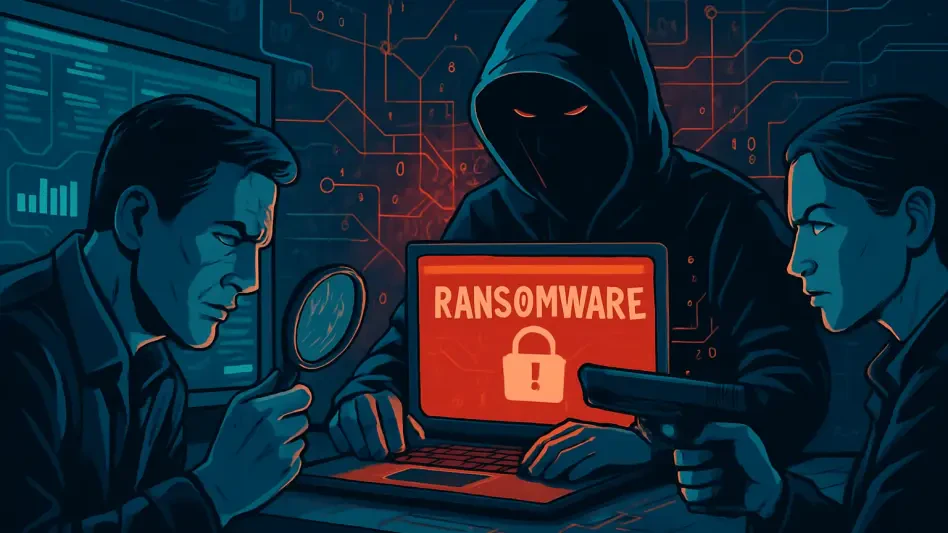What happens when a single individual can hold entire industries hostage with nothing more than a laptop and malicious intent? In a world increasingly reliant on digital infrastructure, the rise of ransomware has become a chilling reality, with one name standing out in the shadows: Volodymyr Viktorovych Tymoshchuk. This Ukrainian national, indicted by the U.S. Department of Justice, is accused of orchestrating a sprawling cybercrime empire that has crippled over 250 American companies and countless others worldwide. With damages soaring into the tens of millions, his story is a stark reminder of the invisible war being waged in cyberspace, where the stakes are higher than ever.
Why This Cyber Threat Matters Now More Than Ever
The significance of Tymoshchuk’s case extends far beyond a single criminal. Ransomware has evolved into a digital epidemic, threatening not just businesses but also hospitals, schools, and governments, with financial losses from individual attacks often hitting millions. High-revenue companies—those earning over $100 million annually—are prime targets, as seen in the calculated strikes attributed to Tymoshchuk. This isn’t just about stolen data; it’s about disrupted lives, halted operations, and a growing fear that no system is truly safe.
The broader impact ripples through economies, exposing vulnerabilities in critical sectors. A healthcare provider unable to access patient records or a manufacturer forced to shut down production lines illustrates the real-world consequences of these attacks. As cybercriminals grow bolder and more strategic, understanding and confronting this menace has become an urgent priority for policymakers, corporations, and individuals alike.
The Mastermind Behind the Malware: Unpacking Tymoshchuk’s Alleged Crimes
Volodymyr Viktorovych Tymoshchuk, known by aliases like “deadforz” and “Boba,” is no ordinary hacker. Indicted in the Eastern District of New York, he stands accused of developing ransomware strains such as Nefilim, LockerGoga, and MegaCortex, tools that have terrorized organizations since at least 2018. His alleged targets include blue-chip corporations and healthcare institutions across the U.S., Europe, and beyond, with a particular focus on entities boasting massive annual revenues.
The scale of his operations is staggering. Over 250 U.S. companies alone have fallen victim, alongside hundreds more globally, resulting in tens of millions in damages from data loss, downtime, and recovery efforts. Tymoshchuk reportedly operated under a “ransomware as a service” model, acting as an administrator who supplied malware to affiliates for a cut of the profits, amplifying the reach of his destructive campaigns.
What sets this case apart is the sophistication of the tactics. As older ransomware variants were countered by cybersecurity measures, new malicious code emerged to exploit fresh vulnerabilities. This adaptability underscores the relentless nature of such cybercriminals, who continue to evolve in the face of mounting defenses, leaving a trail of chaos in their wake.
Global Forces Unite: Law Enforcement’s Relentless Pursuit
The hunt for Tymoshchuk is a testament to international resolve. Assistant Director Christopher Raia of the FBI has made it clear that anonymity online offers no protection, declaring, “Justice will find a way, no matter where criminals hide.” This operation spans over 10 European countries, involving the U.S. Attorney’s Office for the Eastern District of New York, the Department of Justice’s specialized units, and FBI Legal Attachés working in tandem with foreign authorities.
Further emphasizing the urgency, the State Department has announced rewards of up to $10 million for information leading to Tymoshchuk’s arrest or conviction, alongside up to $1 million for details on other key figures in these ransomware networks. Despite these efforts, Tymoshchuk remains a fugitive, a status that only fuels the determination to bring him to account. This global collaboration sends a powerful message: cybercrime knows no borders, and neither does the pursuit of justice.
The involvement of affiliates like Artem Stryzhak, extradited from Spain and awaiting trial in New York, adds another layer to the investigation. Each arrest chips away at the sprawling web of operatives, revealing the complex hierarchy behind these attacks and the critical need for unified action across nations.
The Devastating Fallout: Victims Caught in the Crosshairs
Behind the headlines and statistics lie the real victims of Tymoshchuk’s alleged schemes. Imagine a hospital unable to access critical patient data during an emergency, or a major corporation grinding to a halt as systems are locked by ransomware. These scenarios have played out repeatedly, with sectors ranging from healthcare to industrial manufacturing bearing the brunt of attacks tailored to maximize disruption.
The financial toll is just one part of the equation. Recovery often involves not only monetary costs but also rebuilding trust with clients and stakeholders, a process that can take years. For many smaller entities, a single attack can be catastrophic, forcing tough decisions about whether to pay ransoms or risk permanent closure, highlighting the human cost of this digital scourge.
Specific cases paint a grim picture. Companies targeted often face weeks of downtime, with some reporting losses in the millions for a single incident. This isn’t merely a technical glitch; it’s a calculated assault on livelihoods, exposing the urgent need for stronger safeguards and a collective response to mitigate such widespread harm.
Building a Digital Fortress: Arming Against Ransomware Threats
While Tymoshchuk may still be at large, the fight against ransomware presses on with strategies that organizations and individuals can adopt to protect themselves. Keeping software and systems updated is a fundamental step, closing gaps that cybercriminals exploit with alarming speed. Regular patches can mean the difference between a thwarted attack and a costly breach.
Employee training is equally vital. Phishing emails and suspicious links often serve as entry points for malware like Nefilim, making awareness a powerful line of defense. Meanwhile, maintaining secure, offline backups ensures critical data isn’t held hostage, reducing the incentive to pay ransoms and enabling faster recovery.
Collaboration remains key. Sharing threat intelligence with law enforcement and cybersecurity experts, alongside leveraging resources like FBI alerts, helps stay ahead of evolving tactics. These proactive measures transform lessons from cases like Tymoshchuk’s into actionable shields, empowering everyone to play a role in curbing this pervasive threat.
Reflecting on a Battle Fought in the Shadows
Looking back, the saga of Volodymyr Viktorovych Tymoshchuk revealed the stark reality of ransomware as a weapon that could strike anywhere, anytime. The coordinated efforts of global authorities, from the FBI to European partners, demonstrated an unwavering commitment to dismantling these networks, even as key figures slipped through the cracks. Each step taken—be it an arrest or a reward offered—marked progress in a fight that demanded persistence.
The path forward called for more than just reaction; it necessitated innovation in cybersecurity, stronger international policies, and a cultural shift toward digital vigilance. By investing in education, technology, and partnerships, societies could begin to outpace the adaptability of cybercriminals. The challenge remained daunting, but the resolve to protect critical systems and prevent future devastation stood as a beacon of hope in an ongoing war against unseen enemies.








